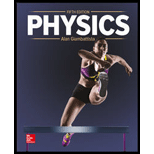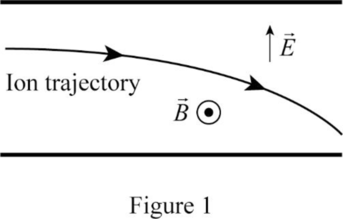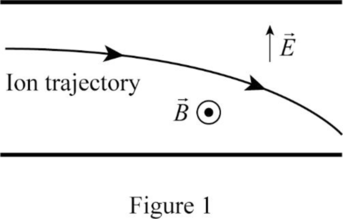
Concept explainers
(a)
The speed with which the
(a)
Answer to Problem 128P
The speed with which the
Explanation of Solution
The kinetic energy gained by the ion must be equal to the potential energy lost.
Write the equation for the conservation of energy.
Here,
Write the equation for
Here,
Write the equation for
Here,
Put equations (II) and (III) in equation (I).
Here,
Write the relation for the speed of
Here,
Write the relation for the speed of
Here,
Take the ratio of the above two equations.
Conclusion:
The charge of the ion
Substitute
Therefore, the speed with which the
(b)
The sketch of the trajectory of
(b)
Answer to Problem 128P
The sketch of the trajectory of

Explanation of Solution
In a velocity selector, for an ion with speed
Write the equation for the magnetic force.
Here,
In the velocity selector,

Conclusion:
Thus, the sketch of the
(c)
The diameter of the path of
(c)
Answer to Problem 128P
The diameter of the path of
Explanation of Solution
Write the equation for the magnitude of the magnetic force on ions using equation (V).
Here,
The magnetic force provides the
Write the relationship between the magnetic force and the centripetal force.
Here,
Write the equation for the magnitude of the centripetal force on ions.
Here,
Write the equation for the radius of a circle.
Here,
Put the above equation in equation (VIII).
Put equations (VI) and (IX) in equation (VII).
Since
Write the relationship between the diameters of the paths of
Here,
Rewrite the above relationship for
Conclusion:
Substitute
Therefore, the diameter of the path of
Want to see more full solutions like this?
Chapter 19 Solutions
Physics
- 20. Two small conducting spheres are placed on top of insulating pads. The 3.7 × 10-10 C sphere is fixed whie the 3.0 × 107 C sphere, initially at rest, is free to move. The mass of each sphere is 0.09 kg. If the spheres are initially 0.10 m apart, how fast will the sphere be moving when they are 1.5 m apart?arrow_forwardpls help on allarrow_forwardpls help on thesearrow_forward
- pls help on all asked questions kindlyarrow_forwardpls help on all asked questions kindlyarrow_forward19. Mount Everest, Earth's highest mountain above sea level, has a peak of 8849 m above sea level. Assume that sea level defines the height of Earth's surface. (re = 6.38 × 106 m, ME = 5.98 × 1024 kg, G = 6.67 × 10 -11 Nm²/kg²) a. Calculate the strength of Earth's gravitational field at a point at the peak of Mount Everest. b. What is the ratio of the strength of Earth's gravitational field at a point 644416m below the surface of the Earth to a point at the top of Mount Everest? C. A tourist watching the sunrise on top of Mount Everest observes a satellite orbiting Earth at an altitude 3580 km above his position. Determine the speed of the satellite.arrow_forward
- pls help on allarrow_forwardpls help on allarrow_forward6. As the distance between two charges decreases, the magnitude of the electric potential energy of the two-charge system: a) Always increases b) Always decreases c) Increases if the charges have the same sign, decreases if they have the opposite signs d) Increases if the charges have the opposite sign, decreases if they have the same sign 7. To analyze the motion of an elastic collision between two charged particles we use conservation of & a) Energy, Velocity b) Momentum, Force c) Mass, Momentum d) Energy, Momentum e) Kinetic Energy, Potential Energyarrow_forward

 College PhysicsPhysicsISBN:9781938168000Author:Paul Peter Urone, Roger HinrichsPublisher:OpenStax College
College PhysicsPhysicsISBN:9781938168000Author:Paul Peter Urone, Roger HinrichsPublisher:OpenStax College Physics for Scientists and Engineers, Technology ...PhysicsISBN:9781305116399Author:Raymond A. Serway, John W. JewettPublisher:Cengage Learning
Physics for Scientists and Engineers, Technology ...PhysicsISBN:9781305116399Author:Raymond A. Serway, John W. JewettPublisher:Cengage Learning Physics for Scientists and Engineers: Foundations...PhysicsISBN:9781133939146Author:Katz, Debora M.Publisher:Cengage Learning
Physics for Scientists and Engineers: Foundations...PhysicsISBN:9781133939146Author:Katz, Debora M.Publisher:Cengage Learning Principles of Physics: A Calculus-Based TextPhysicsISBN:9781133104261Author:Raymond A. Serway, John W. JewettPublisher:Cengage Learning
Principles of Physics: A Calculus-Based TextPhysicsISBN:9781133104261Author:Raymond A. Serway, John W. JewettPublisher:Cengage Learning College PhysicsPhysicsISBN:9781285737027Author:Raymond A. Serway, Chris VuillePublisher:Cengage Learning
College PhysicsPhysicsISBN:9781285737027Author:Raymond A. Serway, Chris VuillePublisher:Cengage Learning





